If you’ve even so much as dipped a toe into fashion on Substack, you likely know of Jamie Haller, the Los Angeles-based designer whose shoes sell-out in seconds. Women, myself included, love Jamie’s soft flats and low heels for many reasons: They’re comfortable, discreet, and extremely well-made. To me, they feel most reminiscent of something you might find in your grandfather’s closet. Old-soul shoes. Wise and exempt from trend.
Before Jamie made shoes, though, she designed jeans, which is why last month’s launch of her denim-heavy ready-to-wear collection was so exciting for me, personally. I couldn’t wait to see what she’d do and talk to her, denim designer to denim designer, about doing it.
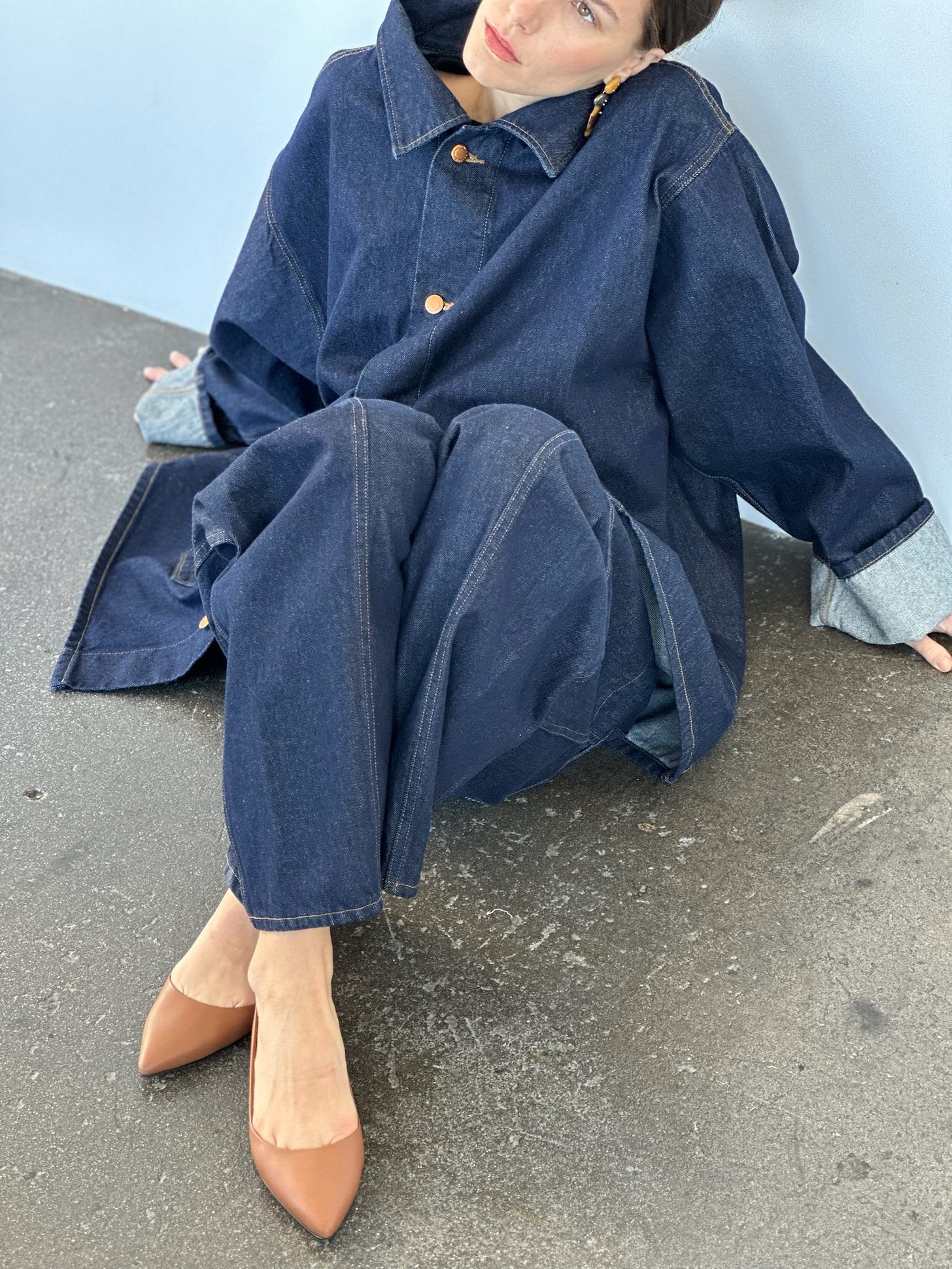
One of the things I admire most about Jamie is her commitment to a multi-disciplinary creative life. Did you know she also restores old houses? Outside the box is one way to think of how Jamie works. Smart is another. “I wanted to leave space for what this is going to be,” she said when we talked right after the first drop. “A launch is just the first stab at it. One of the reasons I didn’t go into jeans only is because I didn’t want anybody to pigeonhole me into being a denim brand. I feel sensitive about that because I like to do lots of things.”
Here, Jamie and I talk about her process, her surprise step into stretch, and – my favorite thing of all – her shoe rules (which shoe to wear with each jean silhouette). Truly, matches made in heaven.
Jane: Let’s start by talking about the launch. For anyone who has started a business or is thinking about starting a business, what was launch like for you. I mean, you have this huge, loyal following of women who love your shoes already. There’s pressure, but so many of us were cheering you on.
Jamie: I feel that. I do feel like people are cheering for me. That came into my mind less, though. I never thought it wasn’t good, but I guess the question was: Will people understand it? Will we make it through production? It’s hard to get through production, especially the first time. And it’s hard to articulate that to anybody because it can sound like you’re complaining. Before the launch I was trying to visualize what success looked like, and I think you can do that by trying to feel, like, ‘OK, what’s the feeling that I’m going to feel if this is really successful?’ And the feeling was relief. The joy of relief. Of knowing that people ordered it and it was well-received. We had a strong first day. All of those things feel like relief to me. I don’t know what another kind of joy feels like. Happiness, I guess. But the bigger feeling is the feeling of relief.

Jane: I didn’t have the courage to launch before I had gotten through production on my first jeans collection. I needed everything to be customer-ready before I could talk about it. I needed to know I could live up to my word.
Jamie: That’s how I started the shoes. For the same reason. Needing to do it to know. But also it was one shoe, it wasn’t 15. It was the Jutti. It was purely just, ‘Oh, I want to remake this for myself.’ There was such an innocence to it. But the jeans – that was a big deal. Even if it’s a little line. For being a little line, it felt big.
Jane: What I love about what you do – and I think about you a lot, personally, when I am trying to find strength or inspiration to keep going – is that you’ve always said that you do many things. Shoes. Houses. Now ready-to-wear. You’re not just one kind of designer. How do all these things connect?
Jamie: It makes so much sense to me. If you like vintage denim, then you essentially are appreciating something that has aged and that has become unique because of special circumstance and use; the way it was cared for, or not cared for. Denim is this evolving story that becomes its own beautiful thing in time. As a denim designer, you try to recreate the effects of time on something. There was an article that came out in 2018 in The New York Times Style section, in which [Hayley Krischer] wrote about me doing old houses and designing denim. There are so many parallels. If you are working on a 120 year-old house, it’s the same love of process. You’re reverse-engineering to get back to that authentic thing. It’s that appreciation for age that creates beauty that you are trying to restore in a house. I tend to specialize in Craftsman houses, but the reason I do those houses is the same reason I do denim. It’s the reverence for the beauty that is inherent in the thing. It’s not manufactured. I don’t buy most things off the rack. And I’m usually ripping out all of the things that people have imposed onto what should be its most authentic and iconic form of a house. Like these old wood floors that you can appreciate because they have marks in them. They are 150 years old. It’s the same value system with denim.
Jane: And you’re self-taught in interiors?
Jamie: Yeah, it was just by the way. I was working in fashion and my husband was working in TV at the time. So in 2012 there was this revolving conversation we were having, which was, ‘How do we prepare for our future? How do we create retirement savings?’ It was my husband’s idea to buy these duplexes and triplexes in L.A., and it was cheap back then, comparatively. So, we would buy these properties and then, because we didn’t know any better, we would just start redoing them. At some point – being the designer that I am – it turned into me wanting to buy a mid-century house to redo. Because why not? It seemed like a great idea at the time [2014]. And it was just this hobby, but we got better and better at it. We were never flippers because that’s not aligned with our values. We were buying historic houses and restoring them. Then we did one that we were selling during the first week of Covid – and everything stopped. But that house got a lot of press, and it turned into people reaching out to me to ask for help.
At the time there was a disillusionment that I had been going through working in fashion for other people for so long. I needed to do something different with my life. I needed to change it up a little bit. So, at the beginning of Covid I started the shoe line. I just needed to create something that was mine. And then I was also doing houses, and I was still working in my job [designing clothes]. I was doing all three. And I really didn’t know how long that work would continue, but also I didn’t care. I just wanted to do whatever I wanted to do. I sound like my five year-old. [Laughs]
Jane: The design job was NSF?
Jamie: Yes. I left 2 years into the pandemic. There wasn’t anything wrong, it’s just that after 12 years, it all blurs and I needed it to pop.
Jane: The first time I met you was at the NSF studio in 2014.
Jamie: I remember. That was our prime time. But even before NSF, I did jeans for 12 years for other people. I think the thing to me that is the clearest now: When I left NSF I was like, ‘I’m just going to work on houses. I need a mental clearing.’ The shoe line was just a hobby. For fun. I made one pair and I did an Instagram…but then all of the sudden, I had a business and sales reps and I was on a wholesale calendar… and still, I didn’t want to do clothes. Until two or three years went by and I started to ask myself, ‘What am I going to wear?’
“I didn’t have to wait for some big change in me to happen to start my own line. I knew what I wanted. It didn’t have to be different. There is no leaving yourself.”
I kept feeling that I needed this big break, and that I was going to turn into somebody else because I had been working for the same company – and before NSF I worked for a brand called Ever – and I just thought I was going to stop working for other companies and become the real me now. There had started to be a divergence between what I wanted to wear as a 40 year-old women and what I was making for a 30 year-old customer. I was wanting to be darker and less washed and more polished but still casual, and the line I was working on wasn’t wanting to go with me. So I thought, I’m going to go through this big change – and I think I did – but it went full circle and I realized, ‘Oh I am the same person I’ve always been. Everything I’ve ever done has purely been me. I’ve always just been me. I’m actually very confident that I am me, and I have always been the same person and the same designer and liked the same things.’ I didn’t have to wait for some big change in me to happen to start my own line. I knew what I wanted. It didn’t have to be different. There is no leaving yourself.
Jane: So how is your ready-to-wear you?
Jamie: I needed casual clothes that still felt forward in silhouette, but that didn’t feel precious or overly styled. Clothes that I could wear in my real life, which was not as editorial. It connected to the idea of what I did with the Loafer. I think the Loafer became something that people really liked because they could wear it with sweats and socks if they wanted, but also just by putting on this one polished thing that still made their life easy, they felt better. Instantly.
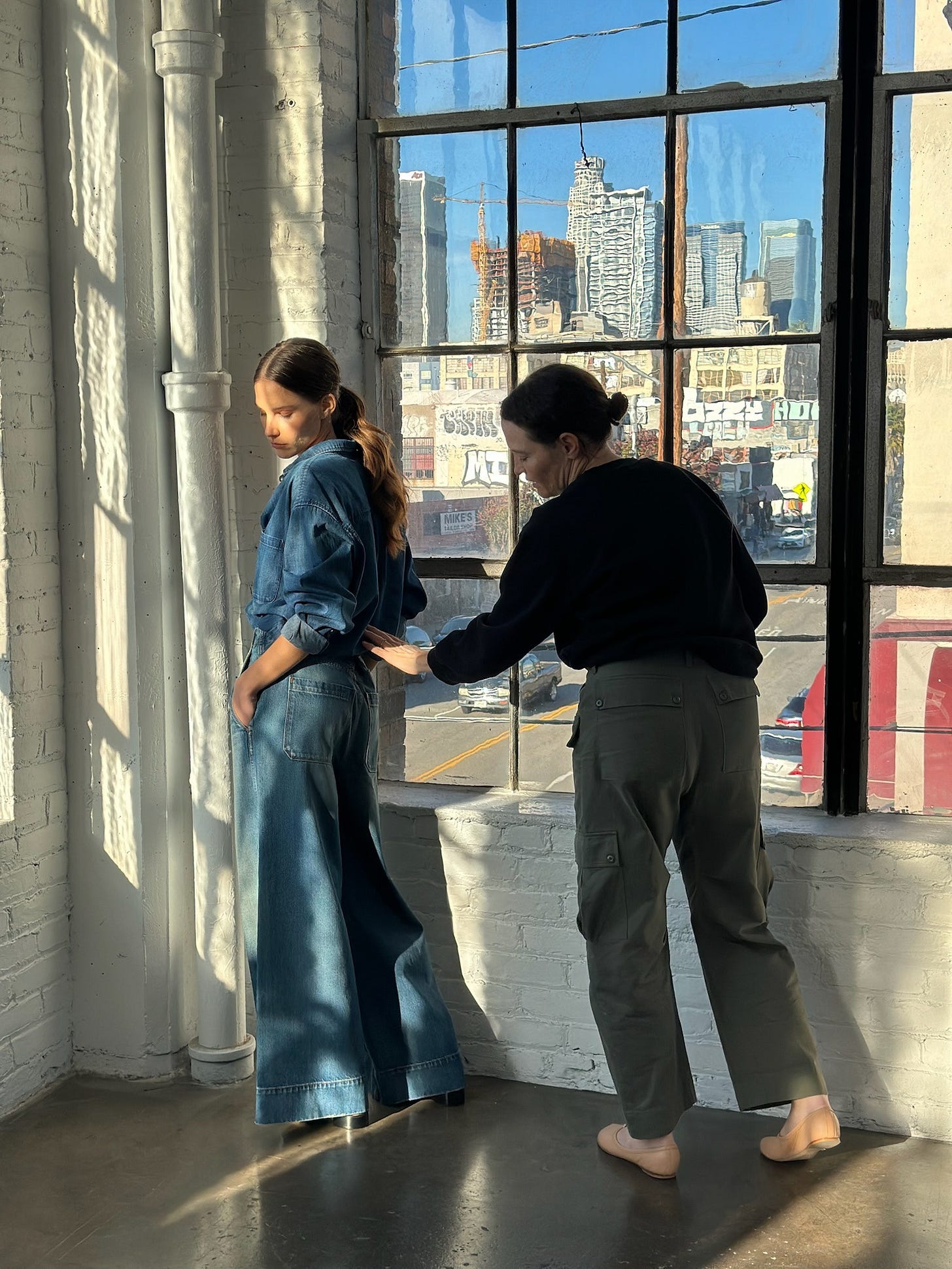
It could just be my experience, but as a woman who’s a mom who’s running a house, and running a business and it’s all the things, feeling pulled together but still like myself makes me feel good. It’s not authentic for me to get dressy every day. I don’t have anywhere to go. Maybe because I live in L.A. But a lot of my clothes have that essence of being for every day. I can wear the Everything Pant and it’s forward enough that I still feel cool. I feel interesting. It has a more advanced shape, but it’s a washable twill, but it’s also just really, really soft. Maybe my personal tastes are more elevated than they used to be, I might be really snobby about cheap fabrics now, so I want everything to feel really expensive. I want a silhouette that I can wear from morning to night, to go get a glass of wine with a friend in, but also schlepp around in all day, without looking too sloppy. Same for the denim. A lot of the styles are casual, and they can be dressed up or dressed down, but mostly I dress things down. Even for me, dressing up is wearing the Crease with a little pointy flat or the Knot heel, or there’s this new Moroccan slide that’s going to come out, with the Sweatshirt. That’s dressy for me, with an earring. I just needed clothes that fit those parts of my life. They’re very elemental things.
Jane: The sweatshirt is such a hit. What makes it special?
Jamie: I was tired of garment dye. I do like garment dye, but it wasn’t elevating me, it was taking me down.So I wanted to do a piece dye sweatshirt, instead. I am pre-washing all of the fabrics to remove shrinkage, and then cut-and-sewing so that I get a more crisp look. It’s like tailored clothing made out of casual fabrics. It makes you feel a little more serious, and I think the saturation of the color looks more polished.
Jane: And with the jeans. Was there something different you did with the jeans?
Jamie: Yes. I did stretch. I’m a snob like you are and I’ve never bought a stretch jean from anybody. So why should I make stretch jeans? Ridiculous! I hate stretch denim. But then, I made one that I like: The Crease. And the Kenickie is also stretch. I am really enjoying the stretch jeans, which is a very different thing from what I am and what I have ever been as a designer.
Jane: What’s the percentage of stretch in your jeans?
Jamie: It’s 2%. There are so many opinions when it comes to stretch denim. Like, it has to be 14oz denim, or it has to be Comfort Stretch, and I just wanted stretch that feels really good on my body. I need my clothes to help me, not hurt me. I wanted stretch that is really comfortable, that holds me in, but that’s not so stiff. I know all the denim people talk about 14oz stretch, but when I put it on I feel like, ‘Oh these are so heavy. They’re going to be so sweaty.’ I wanted it to be lighter, but not too light. There was this breaking away from what everyone else is doing and listening to what I want to wear on my body.
Jane: Where do you start when you’re designing? Fabric? Vintage inspiration?
Jamie: I know what I like, I know what I’m drawn to and it changes here and there, but I’ve been wearing and designing the same things in my mind forever. I want vintage inspired washes because I’m a person inspired by vintage denim, like a lot of denim people are. I want a certain blue to come through. The kind I like, like vintage Levi’s, has a certain look, certain marbling, certain texture, certain openness, certain weave. I’m more apt to pick denims that take me down that wash path, than other denims that would give me a different outcome. Going into spring, I’m doing some ecru. So that’s a different wash path. There are so many variables. The actually process of making jeans can be difficult, but the vision is easy to hold.
Jane: When did you know it was time to start?
Jamie: I was in New York in February 2023 and I had mixed up the dates in the calendar and so I had this whole weekend free alone in New York, accidentally. I was uptown at Bergdorf Goodman trying on every jean – I guess I was shopping for jeans – but I couldn’t find something that I liked. I had posted some of me trying on jeans (because that’s what you do, basically, sometimes), and somebody reached out to me who develops jeans for really well-known denim brands. She and I started talking and I was like, ‘Let’s go for coffee.’ I felt like I wanted to know her. I think in the back of my mind I knew I would end up in denim again, and I can’t physically do everything myself anymore, there are just too many things. So, she started helping me with the development process and that was the beginning. It was July of 2023, and we launched in August 2024. It took about a year.
Jane: It’s so true that as a denim designer, you need help. You need wash technicians and experts. I may know what I want a wash to look like, but the actual formula for achieving that wash, I don’t know how to create that. Maybe that’s specific to the denim industry?
Jamie: It’s a very specialized industry. So when you’re making denim you either have to be willing to make a lot of mistakes. Or you have have to have done it to do it. It’s like 100 more steps than making a t-shirt, so it becomes way more complicated and there is so much room for error. You have to hold the vision and be like, Nope not good enough, try it again. And again.
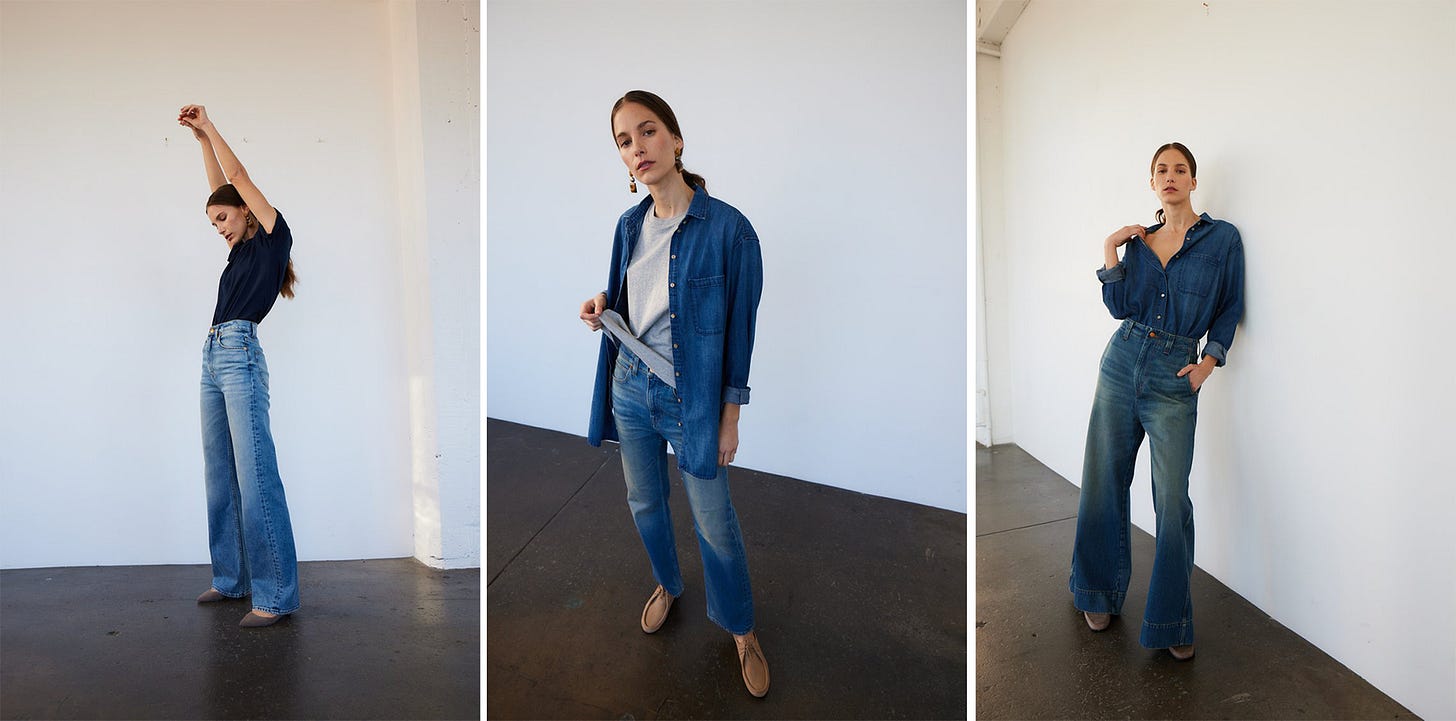
I don’t think I’m like you. You’ve spent so much time learning the history of denim, and I don’t think I’ve paid attention to that. When you talk about the factory code on the top button of a pair of vintage, for example… I have been doing denim for 20 years, but I haven’t paid attention to that stuff. I know I like Orange Tabs. But I’m much more visual process-oriented. I understand the denim, I understand the process, I know how to get it to the wash I’m looking for, and I can make all of the choices to get there. I know what I like. But I’m not necessarily geeking out on the stuff that people can really geek out on. I can appreciate it, but I’ve never held all of that in my mind. I don’t want to front that I know all of those things.
Jane: I don’t think you have to know all those things in order to make great jeans.
Jamie: Yeah. I can look at something down the street at a flea market and be like, ‘Ooh, that’s a good wash,’ and have to go get it from a pile. It’s more of an instant visual recognition of something being good.
“I’m drawn to process and to the story and the unfolding and all of those things. Probably like you, you can always be happy at a flea market finding great jeans. It doesn’t matter that you already have great vintage jeans, there’s always that moment, like, ‘Oh my god, these are so beautiful.’”
Jane: Would you say you enjoy doing denim the most?
Jamie: I do enjoy doing denim a lot. The most? It’s the hardest. I laugh because when I tell people, ‘Oh yeah, I have a shoe line and now I do denim,’ it’s almost silly. The two hardest things. Like, ‘Am I a masochist?’ Those are terrible companies to own. [Laughs] Why can’t I be happy making knit tops? It’s LA. It’s so easy, comparatively. But I think I’m drawn to process and to the story and the unfolding and all of those things. Probably like you, you can always be happy at a flea market finding great jeans. It doesn’t matter that you already have great vintage jeans, there’s always that moment, like, ‘Oh my god, these are so beautiful.’ That’s something that you either possess, or you don’t. And if you possess that you are always going to find joy in that moment.
Jane: What advice or guidance would you give women about buying jeans?
Jamie: I have no idea. For me, I’ve always just leaned into what is authentically me. In homes and in clothes, whenever I am trying to reach for something I see that isn’t me, it doesn’t work.
Jane: Let’s talk about my personal favorite, the Kenickie, which just dropped.
Jamie: I named it for the guy in Grease because I love that style, I love men’s denim. A white t-shirt and a 1950s or 60s pair of denim and a beatnik boot – I love that. I made a men’s 70s loafer. That’s where my heart is, I don’t wear girlie things.
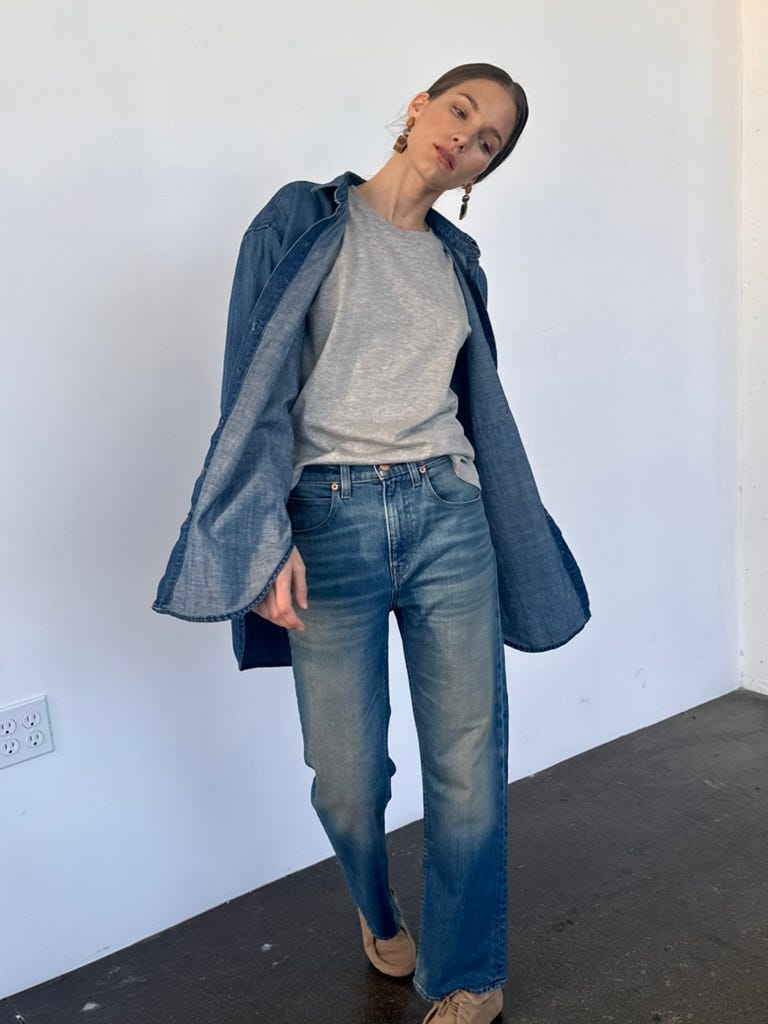
Jane: I love the Kenickie because it’s cropped so you can see your shoes.
Jamie: Not every long jean supports a rounded toe and my biggest style is the Loafer. Me, I wear the Loafer with a little bit of a crop, or a 501 that’s cuffed. I’m very particular. You can’t wear a long jean with the Loafer, you wear a cropped jean with the Loafer. The toe needs to be more elongated to wear a longer jean. But, of course, you can do whatever you want, but in my mind that’s the way it goes. It’s really fun to be able to design the jeans and the shoes and present them together.
“I’m very particular. You can’t wear a long jean with the Loafer, you wear a cropped jean with the Loafer. The toe needs to be more elongated to wear a longer jean.”
Jane: I love that. Tell me more about your rules.
Jamie: In the context of just my line, it’s like: Wear the Crease with the Kitty Point, because you want a little point coming out of the wider, floor-length jean. Or, if you wear the Off Duty you can wear the Kitty Point, or soon we have the Mule coming out that is like a long Moroccan babouche-type shape. I started doing elongated toes because I was doing wider jeans.
For me, I’m more about the Crease than the Kenickie. With the Kenickie you could wear the Loafer or the Chukka or any slipper. You could almost wear any shoe when you have a little ankle showing. I also really like the Kenickie with the Kitty Point. A cropped leg is very shoe-centric.
Sometimes I insert a polish by putting on a pointier shoe with the sweatshirt and jeans, and that creates the tension of the masculine and the feminine together. Usually the clothes are masculine and the accessories are feminine, for me. If you wear it open to the ground, I think the Baggy Painter is really nice with a slipper like the Modern Ballet because it has a little bit of an elongated toe and it has a low vamp, so you see the hint of toe cleavage. It’s really pretty. If I were to wear the Baggy Painter with a Loafer, it’s cute if you do a cuff. I also like the Painter and the Walking Sandal.
The Fatigue is great with Loafers because it hits right above the ankle bone. I also like mixing it with something feminine, like the Knot Heel.
Jane: Would you say the shoes are the filter?
Jamie: For us, internally, the joke is that if it doesn’t go with the Sweatshirt, it doesn’t work. Everything goes back to the Sweatshirt.
I’d love to hear your thoughts on longer interviews like this one. As I come back from summer break, I find myself increasingly more interested in people’s stories and the connections between jeans and real life (like my last letter about the family homestead). Or do you just want me to tell you what to buy for fall? (Jumpsuits are still on sale and the Georgia is back in stock.) Thank you for reading, shopping, sharing, and subscribing at any level. Happy fashion month to those who celebrate and, as always, denim forever.
Jane
More to read…
I’m still getting compliments on the Frame drawstring jeans in this letter.
You can wear white jeans after Labor Day. Here is how.
I’ve seen questions about original hems come up in the JOJ Chat. This is my guide to good denim tailors, for anyone struggling to get it done right.


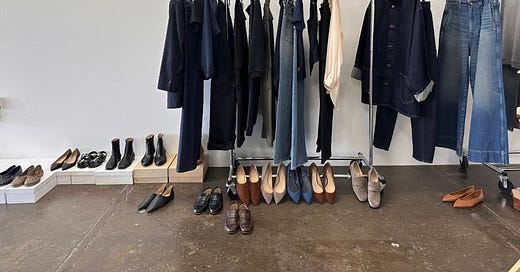


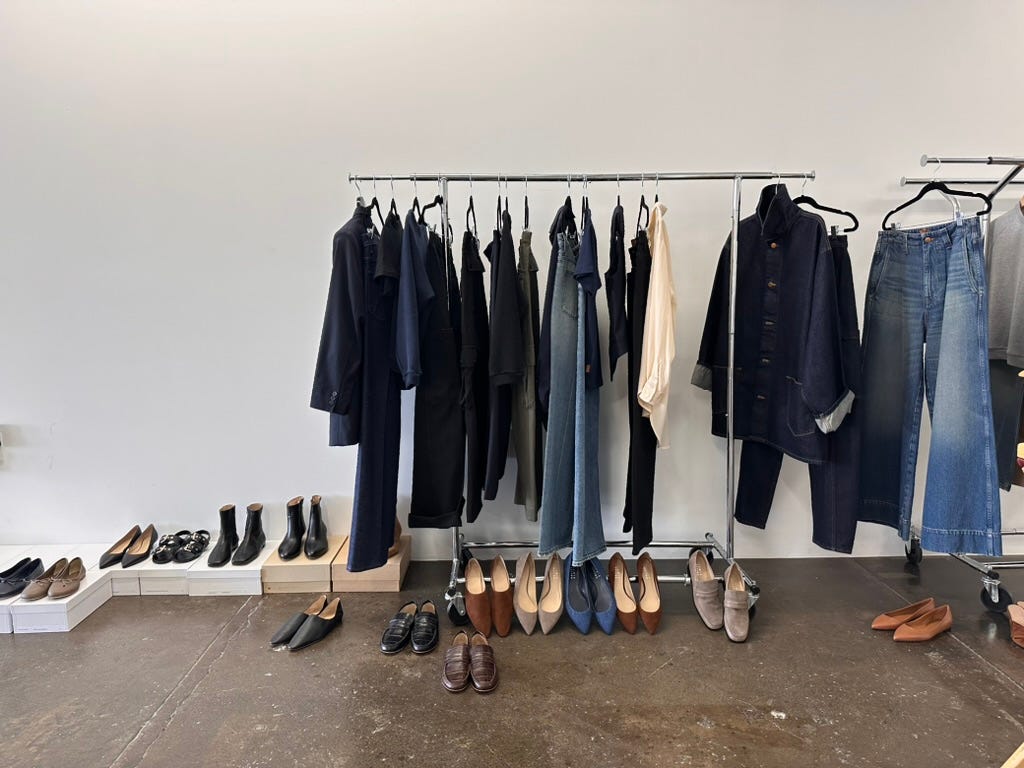

Jane!!! ❤️❤️❤️ 🙏🏼 I loved talking to you
I love your interviews, stories and style from women operating in the real world. But I also very much enjoy your round-ups of what to buy as they cut through the incessant noise. I suppose it’s a balance and for me it is 1 interview for every 3 round-ups. But that’s just me. 🙂